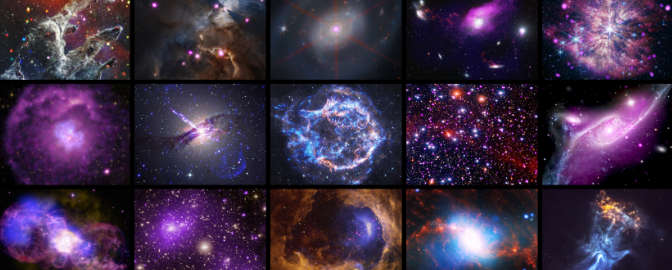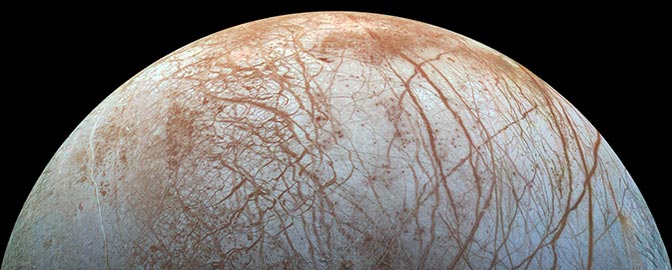The Downlink • Feb 14, 2025
Planetary Valentines
Space Snapshot

Mars may be named after the god of war, but it seems more like a sappy romantic. NASA’s Mars Global Surveyor spacecraft spotted these hearts on the Martian surface throughout its time in orbit. All of them are natural formations, but let’s just go ahead and interpret them as love notes from the red planet. Image credit. NASA/JPL/Malin Space Science Systems.
Fact Worth Sharing

Missing their loved ones isn’t the only toll on an astronaut’s heart. Research aboard the International Space Station suggests that extended time in microgravity can cause the shape of an astronaut’s heart to change from oval to round, and its muscles and blood vessels to atrophy.
Mission Briefings


The Sun just blew you a kiss! OK, maybe it’s just the solar wind. New research suggests that tiny jets of plasma may be the source of a component of the solar wind. This mosaic of images from ESA’s Solar Orbiter spacecraft shows several of those jets (the dark streaks) escaping from the Sun’s outer atmosphere. Image credit: ESA & NASA / Solar Orbiter / EUI Team.

If there’s life on Enceladus, it may be hard to find. New research from the University of Reading in the United Kingdom suggests that Enceladus' subsurface oceans, which seem potentially habitable, may be made of distinct layers through which organic material would have to move very slowly, potentially breaking down before reaching the surface or erupting through geysers into space.

A newly discovered exoplanet system appears to be moving faster than any other. The exoplanet is a super-Neptune orbiting a low-mass star near the center of our Milky Way galaxy, and both appear to be moving at nearly double our Solar System’s speed through the Milky Way, at a staggering 540 kilometers per second (1.2 million miles per hour). If confirmed, this would make it the fastest-moving exoplanet system on record.

Pakistan’s first-ever rover will fly aboard China’s Chang’e-8 Moon mission. The two nations’ space agencies recently finalized an agreement for the collaboration. The mission, due to launch in 2028, will carry rovers contributed by China and Pakistan, two micro-rovers, and a robot.
From The Planetary Society


Home is where the heart is. Maybe someday, it’ll be where the fungus is. A NASA-funded project is exploring the possibility of using mycelium — the root-like structure in fungi — to grow habitats on the Moon or Mars. Learn more about the advantages of growing a home and why mycelium may be the construction material of the future. Pictured: An artist’s impression of a bio-habitat on Mars. Image credit: Redhouse/NASA.

This week on Planetary Radio: an asteroid, an administration, and astrophotography. There’s a lot to cover in this week’s episode of our podcast and radio show, including whether you should be worried about the near-Earth asteroid 2024 YR4, how the Trump Administration’s first actions have affected NASA, and how astrophotographers worldwide can participate in the Astronomy Photographer of the Year competition.

Could Mars Sample Return be a private project? The future of the multi-mission program to return samples from Mars is currently unclear due to budget and schedule issues. The latest episode of Planetary Radio: Space Policy Edition explores how a commercial partnership could be the solution.

To save a mission, two scientists took their message to the Hill. When NASA announced the termination of the VIPER lunar rover mission in July 2024, it sparked a wave of advocacy in support of keeping the mission alive. Read the first-hand account of two planetary scientists who went to Capitol Hill to fight for the mission.

You can advocate for space in Congress too. The Day of Action brings Planetary Society members from across the United States to Washington, D.C., to meet with their representatives in Congress and take direct action to support planetary exploration, planetary defense, and the search for life. This year’s Day of Action takes place on March 24. Early bird registration ends today, so sign up now!
What's Up

This is another great week for planet-gazing. In the evening sky, from west to east, you can see yellowish Saturn, super bright Venus, very bright Jupiter, and reddish, very bright Mars, plus Uranus and Neptune if you have a telescope. On Feb. 16, Venus is the brightest it will be all year, twice as bright as it shines at its dimmest (which is still very bright). Find out more in our guide to February’s night skies.
Help save space missions. Join today!

If you are not already a member, we need your help. NASA is at a crossroads, and your support is needed today! Funding for space science and exploration is not guaranteed. It requires the voice of passionate advocates like you.
NASA is facing major budget cuts for the first time in a decade, and thousands of skilled scientists, engineers, and technicians have already been laid off at NASA centers across the US. NASA funding must grow, not shrink, if the agency is to succeed in returning to the Moon, exploring the Solar System, and seeking out life beyond Earth.
We must prevent future budget cuts. When you become a member of The Planetary Society, you join the world’s largest and most influential space advocacy nonprofit. Will you join us and enable the future of space exploration?
Wow of the Week

Planetary Society member Eddie Parris shared this photo he took using his telescope. It shows the Eagle Nebula, which gets its name from its resemblance to an eagle with outstretched wings. But on Valentine’s Day, one can’t help seeing a heart at its center. Image credit: Eddie Parris.
If you’re a Planetary Society member who does astrophotography, be sure to share your work in the online member community. Every month, we share some of our members' best astrophotography on our Instagram and Facebook accounts.
Send us your artwork!
We love to feature space artwork in the Downlink. If you create any kind of space-related art, we invite you to send it to us by replying to any Downlink email or writing to [email protected]. Please let us know in your email if you’re a Planetary Society member!


 Explore Worlds
Explore Worlds Find Life
Find Life Defend Earth
Defend Earth

